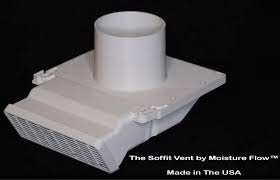The Platinum Standard Of Venting A Bathroom Exhaust Fan by Moisture Flow®
Moisture Flow® now offers a Patented Soffit Vent that is the Platinum Standard of venting a bathroom exhaust fan using the soffit. It solves a problem that has never been addressed in over 40 years. For the first time ever you can place a soffit vent in a vented soffit without the risk of causing mold and moisture damage in the attic.
The Soffit vent by Moisture Flow® provides the homeowners and builders peace of mind eliminating the probability for the need for remediation and repairs to the attic due to mold and moisture damage using the present-day vents sold on the market.
Today our biggest concern is environmental programs for clean air quality, especially in the homes. With the pandemic facing our country, today people are spending more time in their homes and many are working from home. Mold contamination could very well start with mold growth in the attic from moisture damage caused by improper venting of a bath fan.
Once mold growth forms in the attic it will spread throughout the house by transporting the spores by the air movement in the attic.
Several years ago the health insurance companies changed their procedures and required the insured to partake in preemptive measures with an annual checkup to detect or prevent health issues. The Soffit Vent is also a preemptive measure to eliminate mold, moisture damage, and mold contamination in the home.


DoWhy Is The Soffit Vent System So Important?
The Soffit Vent System has solved a long-standing problem in the building industry for the past 40 years. The Soffit Vent by Moisture Flow® has an International Patent that is guaranteed to stop the damage caused by venting a bathroom exhaust fan to a soffit.
It is the only soffit vent placed in the soffit that prevents the extracted moist air from the bathroom from reentering the attic from the passive airflow that is the intake of cool air for the attic’s circulation.
The Soffit Vent System is an adapted termination that now gives builders and homeowners the ability to vent bathroom exhaust fans through the soffit without running the risk of the exhausted air from going back into the attic. It safely and effectively allows venting a bathroom exhaust fan to a soffit. It is a revolutionary alternative to mold remediation and removal, testing and inspection, by venting through the roof.
Cutting into the roof’s sheathing can, and often does, create roof leaks and catastrophic water damage. Venting through the roof can also void a roof warranty. The Soffit Vent System is code compliant under The International Code Council (ICC) and the International Residential Code (IRC).
How Does The Soffit Vent System Work?
By effectively displaces exhausted air from a bathroom exhaust fan, through a soffit, and out of the soffit’s passive air stream. Effective displacement subscribes to the removal of exhausted air away from the assembly and preventing reentry. Our Soffit Vent has multiple egress points for bulk moisture, should moisture condense inside the vent. These egress points also prevent the reentry of moisture into the attic and avoid moisture build-up inside the duct.
The vent is designed for soffits ranging from 8″ to 48″ long. Unique in its function and design, the Soffit Vent System is the only product on the market that takes the exhausting air out of the soffit’s passive air stream. The soffit is designed to take in air, helping to ventilate the roof deck. Subsequently, any air vented within the soffit’s airstream will end up back in the attic. This promotes moisture problems and mold growth.
For these reasons – in the residential energy efficiency industry – venting a bath fan into the soffit is considered the least ideal place for venting and is oftentimes utilized as a last resort. This soffit vent termination is unquestionably an industry first. It not only gives builders an effective and viable alternative to venting to the roof or gable wall, but it is also now the best way to vent a bath fan.
What Do Soffits Do?
Soffits serve both an aesthetic and functional purpose for a building’s roofing system. It’s the skin that covers your eaves. Without it, you would expose your rafters. Functionally, it is the roof’s passive air intake for ventilation. Are there consequences of improper venting? An attic is not part of the living space, is “out of sight out of mind,” with inspections few and far between.
Once the mold is visible on the ceilings and walls beneath the attic, then the mold is already in an advanced growth stage. In the USA, homeowners spend over $15 billion annually on remediation caused by attic mold and moisture damage. The healthcare costs from mold contamination and the loss of business productivity exceed half a trillion dollars annually. Mold contamination also affects domestic animals, which can cost homeowners thousands of dollars in medical treatment.
How Do Bath Fan Venting Causes Attic Mold and Moisture Damage?
The four most common causes are:
(1) The bathroom exhaust fan or the fan’s transition duct vents directly into the attic.
(2) Venting directly into the soffit.
(3) deterioration of a roof vent exposed to the climatic conditions connected to the bathroom exhaust fan.
(4) Gable Vents compromise the effectiveness of removing the heat and humidity and cause mold formation and condensation in the attic.
The Soffit Vent System eliminates all of these risk factors—ideal for anyone with an exhaust fan in your bathroom(s).
The Soffit Vent System is perfect for national home builders and contractors in the home improvement industry, the 295 million existing homes, 5.6 million commercial buildings, and the 50 million do-it-yourself (DIY) homeowners in the USA. Warranty: The Soffit Vent comes with a standard, no questions asked, lifetime warranty.
